Serendip is an independent site partnering with faculty at multiple colleges and universities around the world. Happy exploring!
Notes Towards Day 1 (T, Jan.17): Welcome to the Dinner Party!

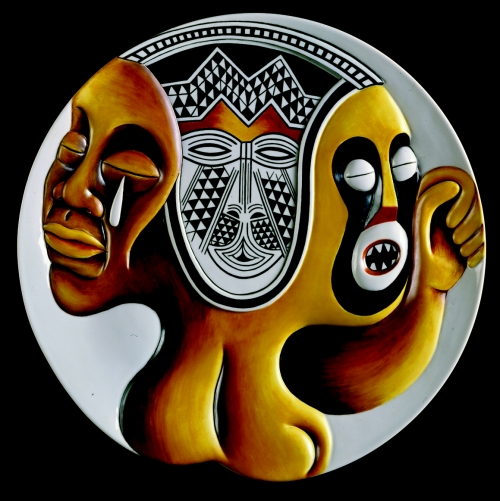
Let's start by reading this image:
write for five minutes about what you see.
Turn to your neighbor, introduce yourself, and
tell her what your reaction was to the image
Go 'round: say your name, and something
you just learned in this conversation (about/
from your neighbor, the image, feminism, pedagogy....?)
What the artist said:
"Three faces, emanating from a single body form, were inspired by African art. The sad face on the left is painted naturalistically and weeps for the suffering of the slaves. The highly stylized face on the right reflects the rage experienced by black women but expressed only at the risk of harsh punishment - sometimes death. The center face, a highly decorated mask, symbolizes the concealment of the real self required not only of black women, but of their white sisters as well." (The Dinner Party: A Symbol of Our Heritage, p. 88)
What a contemporary artist said:
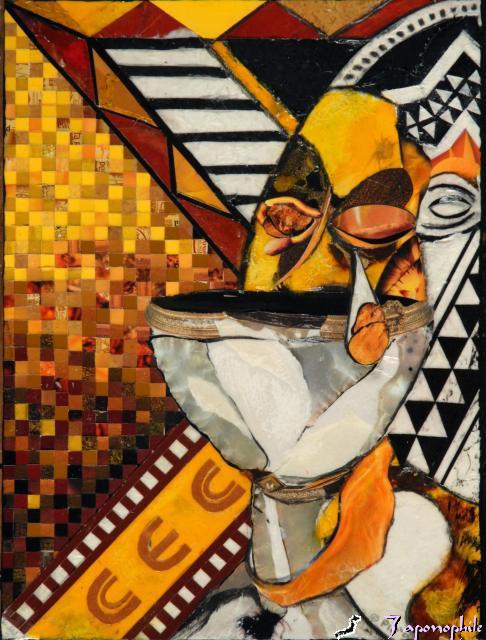
Marsha Monroe Pippenger, "Dinner in the City":
The tribal designs call attention to the sorrowful face weeping for
those who have suffered the indignities of slavery.
Jonathan Culler: "meaning is context-bound—and context is boundless"
give you some context: this is an image of Sojourner Truth;
(now permanent collection of Brooklyn Museum of Art)
of The Dinner Party, by artist named Judy Chicago
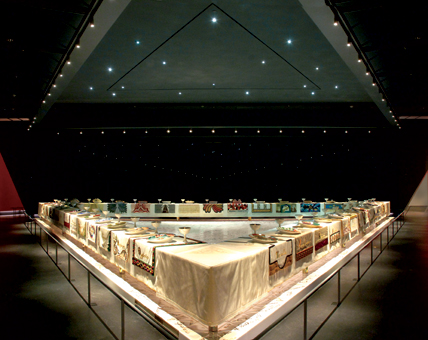
this is what Judy Chicago did:
selected 1038 women in western history
inscribed names of 999 of them on porcelain floor tiles
honored 39 of them w/ symbolical place settings @ a table:
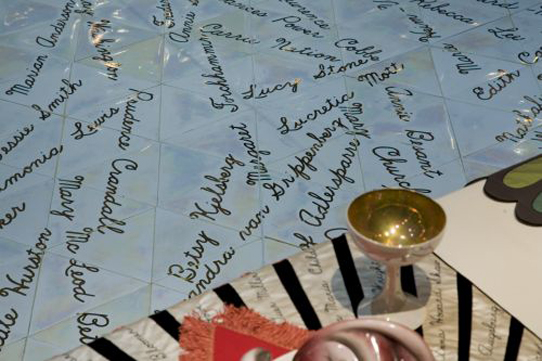
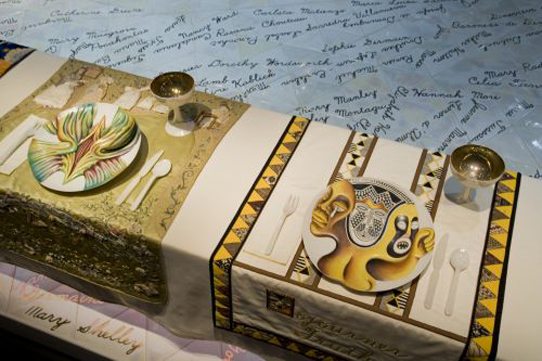
Many problematics to this project... but (before I get to them!) let's pause for a moment:
are there names that you would expect to see @ the table?
names that you know that you would want to see/set on the table? in the floor?
dimensions of feminism that you are already familiar with--> or don't know/know you'd like to explore?
(i.e. hope we might bring to the table?) let's write these down (could be in the form of a question...)
we will be setting a table together here, and I'll explain in a little how this will happen.
but first: how Judy Chicago did it:
her table is an equilateral triangle, w/ 13 settings on each side
each one got a china plate in a vulvar form,
elaborate needlepoint runner worked in period techniques,
narrating the life of the woman who is figured there
(Sojourner Truth: pieced quilt of strip-woven African patterns,
combined w/ triangular sections of printed fabric,
to honor slaves who pieced weaving from home into large quilts)
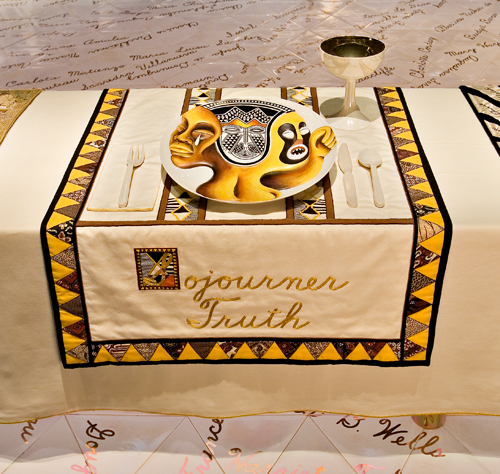
the work of art was created in a particular historical moment,
in the U.S. in the 1970's: 2nd wave feminism
(do you know the 1st and 3rd??)
positive mode of representing female body,
reclaiming it from patriarchal construction as passive, fetishized
from flat ancient goddesses representing relative constraint/containment
to sculptural thrusts of Virginia Woolf: creative female subject,
active vaginal forms, muscular, 3D
in context of high modernism/pure abstract aesthestic objects
deliberate choice to use media associated w/
women's domestic labor (china painting, ceramics, needlepoint)
and to make the form monumental
intensely controversial exhibit
1. damned by postmodern feminists as biologically essentialist, naïve
2. dismissed by modernist art critics as pornographic kitsch
transgressive/in-your-face threat to inherent artistic value
----both in over-celebration of craft
(make debased sentimental domestic art form monumental;
handmade female crafts aggressively, blatantly sculptural)
----and by flamboyant exploration of boundaries of aesthetic value
explicit sexualization/politicization of history of women's culture
“feminized restaging of all-male club of Last Supper,
from point of view of those who cooked it"
but not figured as hands; rather:
direct, relentless, biologically redundant
representation of labial folds
3. also dismissed by feminist artists/art historians because populist
this period in feminist art criticism→
rampant anti-pleasure rhetoric
don’t be captured by illusions:
dis-identifactory practices erode cultural consumption
4. dismissed by radical feminists who shared
Judy Chicago's aesthetics, but not her politics:
feminism challenges exclusionary, elitist system of values
but Chicago aimed @ elevating women to state of transcendence,
w/out questioning exclusions that transcendence implies
she was invested in upholding opposition between high/low art,
ascribed to structure of value she critiqued:
wanted installation viewed as high art
not only reinforced masculinist notions of greatness
but self as “Master of Studio”
betrayed a feminist commitment to collaboration
5. strongest critique, however, came from women of color,
who asked the most compelling questions of the exhibition:
how does ST plate differ from “mold” I’ve described,
of relentlessly biological vulvar forms?
One place set for black woman,
only one in collection that shows a face instead of a vagina
(actually three faces!)
Alice Walker wrote in Ms. Magazine abt.
Chicago’s ignorance of black women artists
“white women can’t imagine black women have vaginas;
or if they can, where imagination leads them is too far to go”
exposes hesitancy of white feminists
in relation to black female sexuality
6. most important critique of TDP as comprehensive narrative of women’s history
came from a group of Hispanic women fr. National Woman’s Political Caucus, who visited studio in 1978,
and wrote a letter complaining that no pre-conquest New World heroines were honored @ table;
called for boycott and letter writing protest
chose to begin w/ Sojourner Truth plate as opening image for this course:
graphic portrayal of basic assumptions about what feminist art/can do/
what feminist reading is/can do
about varieties of both art & reading
and—most importantly—because
the woman this plate figures was illiterate
what do you know of her/her speeches?
Much of what she has to say --"Aren't I a woman?"--
(can read more speeches later in semester if you chose)
is about class, about expanding the category “woman” from lady,
to include women like herself who were not isolated @ home but labored in the field, enslaved
significant: these speeches were transcribed
(most famous perhaps invented) by literate white women who heard her speak
since she wrote nothing herself, these texts of speeches
(and narrative of her life, written by Olive Gilbert, clearly ventriloquized)
raise questions abt. authenticity
on the one hand, other women "gave voice" to her;
on the other, she constructed herself, was own myth maker
Nell Painter on her visiting cards: free bourgeois matron
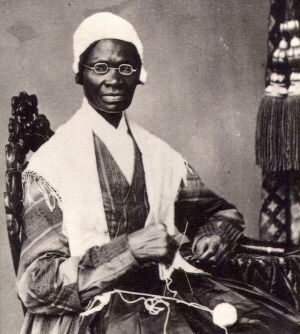

assembled appendix to Narrative in 1875,
w/ newspaper reports, autographs, collage of accolades;
dictated account of her warm mtg. w/ Lincoln
(she hadn’t heard of him; he’d heard often of her)
capacity to claim symbolic identity
and did some powerful speaking
--took master’s family to court for selling her son to Ala; got him back
--twice took D.C. streetcar conductors to court for refusing to let her ride,
one for assault and battery, both victorious
all that is to figure this course called Critical Feminist Studies
start to give you a sense of how I’m proposing that we take on a # of difficult jobs:
select out of the history of feminism whose work to read!
select who to read--but also interrogate what it means to write & read as a feminist:
problematizing acts of representing and interpreting objects we read and write
attend to the political dimensions of reading, writing (selecting is political....)
Highlight not only gendered but racial/classed/national limits of that activity
(class valences of “dinner party”!)
literacy about politics, empowerment, agency
African slaves were denied literacy
(FDouglas: “teaching a slave to read would forever unfit him to be a slave”)
pathway to liberty (cf. today: 70% males in prison not completed h.s.,
40% functionally illiterate, 19% illiterate)
to be inarticulate is to in jeopardy;
we use words to express who we are,
& to challenge, organize for better world
teaching/reading/writing for social justice
James Baldwin, "A Talk to Teachers": paradox of education—
examine society in which you are being educated,
create ability to make own decisions, imagine alternatives
What I've designed of our syllabus --so far! -- is on-line @
/exchange/courses/critfemstudies/s12
you should bookmark this, and check it in preparation for every class;
it will change as the semester goes on, so be sure to "re-fresh" each time you go back
I'm going to take you now to a # of other webpages that you'll be using for the course;
all of them are available from this homepage.
For instance: you’ll have reading to do for each class;
much of this will be available on-line, including Thursday's reading:
Christine Rossetti's 1862 poem, "Goblin Market"
you should also rent/buy/borrow/share four books:
Virginia Woolf, 3 Guineas (for next week: also available on-line...)
Marjane Satrapi, The Complete Persepolis,
Monique Truong, The Book of Salt &
Jeffrey Eugenides, Middlesex
We'll decide together what we'll be reading/watching
for last month of the semester: contemporary science fiction? film? dance?
as particular questions are brought to the table, particular texts will seem
appropriate @ that point in time; we’ll see...an emergent process!
I am asking you to read and to write regularly, both in and out of class,
and to meet with me @ least twice (before the first and last writing
projects are due) to discuss your thinking and your writing.
What's unique about this course is that -- besides talking w/ each other in person,
and handing in one piece of more formal writing each month,
and having conferences about your writing --we will be meeting virtually,
over each weekend, in an inbetween space: our on-line/class forum @
/exchange/courses/critfemstudies/s12/conversation
By each Sunday evening, I am asking you to post a comment in that space,
reflecting on our discussion from the week before, anticipating what's upcoming
(more deliberate than speaking in class, less formal than written work:
excellent place for showcasing revisionary thinking).
To do the postings, you need to follow these instructions-->
register now (before Thursday's class), so you'll have your password,
and be set to go on Sunday evening, when your first posting is due.
This informal writing is background/preparation/warm-up/frequent source
for your more “formal” writing assignments, which will also
take the form of four "web events," due once/month
(three 4-pp. projects, one 12-pp).
That's the basic pattern for our thinking-and-writing:
for each class, we'll have some new material to read and discuss together.
By 5 p.m. each Sunday evening, post a short comment
in our on-line course forum, reflecting back on/for forwards toward our discussion.
What is (probably) also distinct about this course is the form of evaluation:
I will not grade any of your individual papers. @ the end of the semester,
you will complete a portfolio of all your work, and evaluate yourself.
The checklist of my expectations, are all on-line
(this is not mysterious: be present in class and conferences,
contribute in-person and on-line, post your web events on time,
be responsive to instruction, engaged in the conversation...).
N.B.: my (feminist!) belief in education as a collective endeavor,
our shared responsibility for each other's learning....
Talking about "accomodations" (cf. syllabus statement from Access Services).
we will all of us need a little space, a little "slack," in the course of the semester;
to "accomodate this," our shared responsibility involves letting one another know,
making alternative arrangements (for ex, if you need to miss class, read the
course notes, do another posting "saying" what you might have said,
had you been here...)
What else?
Questions about any of these details of "course-keeping"?
reminder that links to all these pages--on-line course forum,
syllabus, instructions for posting, a growing file of my "talking notes"
for class--are available as links from our course home page @
/exchange/courses/critfemstudies/s12
For Thursday: read "Goblin Market" on-line,
and come ready to report on that experience...


